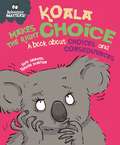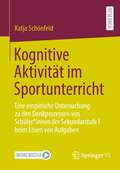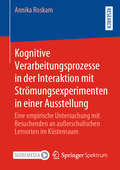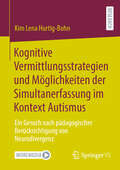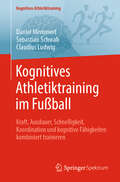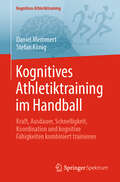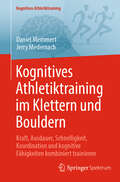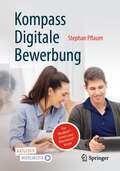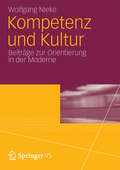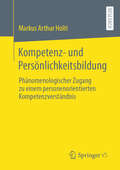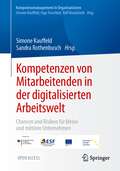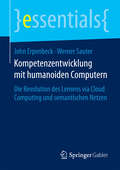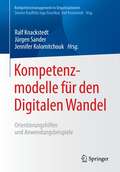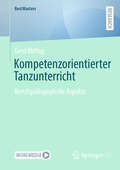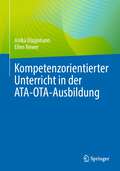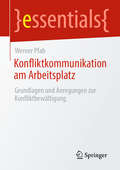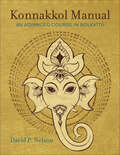- Table View
- List View
Koala Goes on Holiday (Experiences Matter)
by Sue GravesKoala Goes on Holiday offers a gentle introduction to the experience of being away from home for young children.This funny, charming story is the perfect way to introduce young children to the experience of being away from their familiar surroundings. Also included are suggestions for activities and ideas to talk through together to help children reflect on their own experiences.Koala is going on holiday, and everyone is very excited - everyone except Koala. She is nervous about being away from home. What if she doesn't like the beach? What if she doesn't like the food? Luckily, her sister is there to reassure her...The Experiences Matter series of picture books provide a gentle means of discussing experiences, boosting self-esteem and reinforcing good behaviour. Supports the Personal, Social and Emotional Development Area of Learning in the Early Years Foundation Stage, and is also suitable for use with children in KS1 and can be used to discuss values. Suitable for children under 5.
Koala Makes the Right Choice: A book about choices and consequences (Behaviour Matters #37)
by Sue GravesKoala Makes the Right Choice offers a gentle introduction to the concepts of choice and consequence.This funny, charming story is the perfect way to introduce young children to choices, and helps them find ways to make decisions and understand consequences. Also included are suggestions for activities and ideas to talk through together to help children understand their behaviour.The Behaviour Matters series of picture books provide a gentle means of discussing emotions, boosting self-esteem and reinforcing good behaviour. Supports the Personal, Social and Emotional Development Area of Learning in the Early Years Foundation Stage, and is also suitable for use with children in KS1 and can be used to discuss values. Suitable for children under 5.
Koalas (Readers)
by Laura MarshWith a seemingly permanent half-smile on their face, koalas are appealing to boys and girls alike. Filled with adorable photos, and carefully leveled text, this level 1 reader introduces beginning readers to these furry creatures, from cub to adult, exploring where they live, what they eat, and even the way they say "hello"—by touching noses!National Geographic supports K-12 educators with ELA Common Core Resources.Visit www.natgeoed.org/commoncore for more information.
Kognitive Aktivität im Sportunterricht: Eine empirische Untersuchung zu den Denkprozessen von Schüler*innen der Sekundarstufe I beim Lösen von Aufgaben
by Katja SchönfeldAus einer sportdidaktischen Perspektive geht Katja Schönfeld der Frage nach, wie sich kognitive Aktivität von Schülerinnen und Schülern im Sportunterricht charakterisiert. Anknüpfend am Diskurs um kognitive Aktivierung als eines der zentralen Merkmale von Unterrichtsqualität zeigt die Autorin auf, weshalb kognitive Aktivierung auch für den Sportunterricht von Bedeutung ist und welchen Mehrwert die Betrachtung dieses Merkmals aus Sicht der Schülerinnen und Schüler bietet. Dabei beleuchtet sie auch, wie sich kognitive Aktivität von Schülerinnen und Schülern beim Lösen von Aufgaben im Sportunterricht erfassen lässt und präsentiert vier verschiedene Denkmuster (sogenannte Modi der kognitiven Aktivität), welche in der empirischen Untersuchung identifiziert werden konnten.
Kognitive Verarbeitungsprozesse in der Interaktion mit Strömungsexperimenten in einer Ausstellung: Eine empirische Untersuchung mit Besuchenden an außerschulischen Lernorten im Küstenraum
by Annika RoskamDer Küstenraum ist ein dynamisches System, welches sensibel auf Veränderungen reagiert. Aufgrund der hohen Dynamik ist das Wattenmeer 2009 zum UNESCO Weltnaturerbe ernannt worden. Um diese besondere Bedeutung auch in außerschulischen Lernorten zu vermitteln, wird eine Ausstellung zu Strömungsphänomenen konzipiert und erprobt. Dabei werden kognitive Verarbeitungsprozesse von Besuchenden in der Interaktion mit Experimenten zu Strömungsphänomenen untersucht. Im Sinne des Design-based Research werden Weiterentwicklungen und Generalisierungen herausgearbeitet. Die Ergebnisse der empirischen Untersuchung sind in dieser Arbeit dargestellt, insbesondere werden Leitlinien für die Konzeption bzw. Weiterentwicklung von interaktiven Ausstellungen abgeleitet.
Kognitive Vermittlungsstrategien und Möglichkeiten der Simultanerfassung im Kontext Autismus: Ein Gesuch nach pädagogischer Berücksichtigung von Neurodivergenz
by Kim Lena Hurtig-BohnDie Komplexität des Autismus-Spektrums ist unbestritten, spiegelt sich jedoch in den etablierten und gelebten pädagogischen Konzepten selten wider. Die Überbetonung visueller Strukturierungshilfen im pädagogischen Setting wird in diesem Buch in einer Grundlagenforschung mit Mixed-Methods hinterfragt. Darüber hinaus wird ein Schwerpunkt auf das Thema Neurodiversität gelegt. Es wird eine gesellschaftliche Metaebene geschaffen, um die bedeutende Anzahl der Schüler*innen aus dem Autismus-Spektrum mit dem Wunsch nach einem gesellschaftlichen Wandel zu mehr Offenheit für Personen aus dem Neurodiversitätsspektrum in Schule zu verknüpfen. Der Einbezug der gesellschaftlichen Dimension der Neurodiversität lässt die Notwendigkeit erkennen, fundiertes Fachwissen in Bezug auf Autismus vermehrt an pädagogische Fachkräfte vermitteln zu müssen, um den Schüler*innen aus dem Autismus-Spektrum generalisierte Möglichkeiten zu bieten, ihre Potenziale zu entfalten.
Kognitives Athletiktraining im Fußball: Kraft, Ausdauer, Schnelligkeit, Koordination und kognitive Fähigkeiten kombiniert trainieren (Kognitives Athletiktraining)
by Daniel Memmert Sebastian Schwab Claudius LudwigDie Buchreihe Kognitives Athletiktraining informiert in praxisorientierten und wissenschaftlich fundierten Einzelbänden über die Durchführung eines kognitiven Athletiktrainings in verschiedenen Sportarten. Jeder Reihentitel greift eine spezifische Sportart auf und beantwortet die übergeordnete Frage: „Mit welchen Spiel- und Übungsformen kann die Kognition parallel zu Athletik und Kondition trainiert werden?&“ Dabei stehen kognitive Fähigkeiten wie z. B. Wahrnehmung, Kreativität, Antizipation und Aufmerksamkeit sowie konditionelle Fähigkeiten wie Kraft, Ausdauer, Schnelligkeit und Koordination im Fokus. Die Bücher sind didaktisch-methodisch ausgelegt, enthalten viele Beispiele und überzeugen durch eine kompakte und übersichtliche Aufmachung im Theorieteil. Zahlreiche Fotos und Abbildungen erleichtern die Umsetzung der verschiedenen Spiel- und Übungsformen im Praxisteil, der den wesentlichen Anteil der Bücher ausmacht. Die Buchreihe richtet sich insbesondere an Trainer*innen im Leistungs- und Breitensport, an interessierte Sportler*innen sowie an Studierende der Sportwissenschaft. Die Autor*innen der Reihentitel lehren und forschen an Universitäten, sind selbst als Trainer*innen aktiv oder engagieren sich in den Dachverbänden der jeweiligen Sportarten.
Kognitives Athletiktraining im Handball: Kraft, Ausdauer, Schnelligkeit, Koordination und kognitive Fähigkeiten kombiniert trainieren (Kognitives Athletiktraining)
by Daniel Memmert Stefan KönigDie Buchreihe Kognitives Athletiktraining informiert in praxisorientierten und wissenschaftlich fundierten Einzelbänden über die Durchführung eines kognitiven Athletiktrainings in verschiedenen Sportarten. Jeder Reihentitel greift eine spezifische Sportart auf und beantwortet die übergeordnete Frage: „Mit welchen Spiel- und Übungsformen kann die Kognition parallel zu Athletik und Kondition trainiert werden?&“ Dabei stehen kognitive Fähigkeiten wie z. B. Wahrnehmung, Kreativität, Antizipation und Aufmerksamkeit sowie konditionelle Fähigkeiten wie Kraft, Ausdauer, Schnelligkeit und Koordination im Fokus. Die Bücher sind didaktisch-methodisch ausgelegt, enthalten viele Beispiele und überzeugen durch eine kompakte und übersichtliche Aufmachung im Theorieteil. Zahlreiche Fotos und Abbildungen erleichtern die Umsetzung der verschiedenen Spiel- und Übungsformen im Praxisteil, der den wesentlichen Anteil der Bücher ausmacht. Die Buchreihe richtet sich insbesondere an Trainer*innen im Leistungs- und Breitensport, an interessierte Sportler*innen sowie an Studierende der Sportwissenschaft. Die Autor*innen der Reihentitel lehren und forschen an Universitäten, sind selbst als Trainer*innen aktiv oder engagieren sich in den Dachverbänden der jeweiligen Sportarten.
Kognitives Athletiktraining im Klettern und Bouldern: Kraft, Ausdauer, Schnelligkeit, Koordination und kognitive Fähigkeiten kombiniert trainieren (Kognitives Athletiktraining)
by Daniel Memmert Jerry MedernachDie Buchreihe Kognitives Athletiktraining informiert in praxisorientierten und wissenschaftlich fundierten Einzelbänden über die Durchführung eines kognitiven Athletiktrainings in verschiedenen Sportarten. Jeder Reihentitel greift eine spezifische Sportart auf und beantwortet die übergeordnete Frage: „Mit welchen Spiel- und Übungsformen kann die Kognition parallel zu Athletik und Kondition trainiert werden?&“ Dabei stehen kognitive Fähigkeiten wie z. B. Wahrnehmung, Kreativität, Antizipation und Aufmerksamkeit sowie konditionelle Fähigkeiten wie Kraft, Ausdauer, Schnelligkeit und Koordination im Fokus. Die Bücher sind didaktisch-methodisch ausgelegt, enthalten viele Beispiele und überzeugen durch eine kompakte und übersichtliche Aufmachung im Theorieteil. Zahlreiche Fotos und Abbildungen erleichtern die Umsetzung der verschiedenen Spiel- und Übungsformen im Praxisteil, der den wesentlichen Anteil der Bücher ausmacht. Die Buchreihe richtet sich insbesondere an Trainer*innen im Leistungs- und Breitensport, an interessierte Sportler*innen sowie an Studierende der Sportwissenschaft. Die Autor*innen der Reihentitel lehren und forschen an Universitäten, sind selbst als Trainer*innen aktiv oder engagieren sich in den Dachverbänden der jeweiligen Sportarten.
KokoCat, Inside and Out
by Nancy Lane Lynda Graham-BarberOne day, KokoCat, a well-loved housecat, sees an open door, a chance to escape her pleasant life, to explore an exciting world outdoors. Once outside, she finds that life is more frightening and less enjoyable than she bargained for. Hungry, lost, and alone, KokoCat takes shelter under a dumpster and dreams of her former life inside. In vibrant images, KokoCat's story shows the reader that keeping a domestic cat indoors is better both for the well being and longevity of the cat as well as for the birds and wild animals on which a cat preys. The book's final page for parents and adults offers important information, provocative questions, and tips to increase young readers' awareness of this important animal health and welfare issue. Lynda Graham-Barber's abiding passions for writing and animals have intermingled for four-decades, as children's book editor, writing teacher, author of thirteen books, and animal rights advocate. The author, who holds an MFA in writing for children from Vermont College, lives in a small stone cottage, which she helped build, situated on 160 wooded acres in the Northeast Kingdom, Vermont, with her artist husband David and their rescued dog Biscuit. Nancy Lane has been an award-winning illustrator for the last twenty years. Her picture books include Call the Horse Lucky and A Home for Dakota (both from The Gryphon Press). She lives in the Finger Lakes region of upstate New York with her family and her rescued dog and cats.
Kommunikation zwischen Eltern und elementarpädagogischen Fachkräften im Kindergarten: Relevanz, Beschaffenheit und Einflussfaktoren
by Laura BurkhardtKommunikation mit Eltern gilt als herausfordernder Teil der Arbeit frühpädagogischer Fachkräfte – gestiegene Anforderungen an das elementarpädagogische Berufsfeld spiegeln sich in diesem Arbeitsbereich wider. Allerdings sind angenommene positive Wirkungen der Zusammenarbeit zwischen elementarpädagogischen Fachkräften und Eltern auf die kindliche Entwicklung theoretisch und empirisch dünn untermauert. Außerdem ist wenig empirisches Wissen darüber vorhanden, wie Kommunikation (als Grundlage für Zusammenarbeit) in der Praxis beschaffen ist, sowie darüber, welche Aspekte Fachkräfte und Eltern für wichtig halten – insbesondere in Österreich. Vor diesem Hintergrund beleuchtet die Autorin in der vorliegenden Arbeit zum einen die theoretische Bedeutung von Kommunikation zwischen frühpädagogischen Fachkräften und Eltern. Zum anderen untersuchte sie mittels Fragebogen in Tirol (Österreich), in welchen Formen die Eltern-Fachkraft-Kommunikation in Kindergärten wie häufig stattfindet, um welche Inhalte es wie häufig geht, wie relevant die Beteiligten verschiedene Kommunikationsformen und -inhalte finden und welche Merkmale Einfluss darauf haben, welche Inhalte sie als häufig und relevant einschätzen. Die Autorin diskutiert die Ergebnisse im theoretischen Kontext und hinsichtlich ihrer Implikationen für elementarpädagogische Aus- und Weiterbildungen.
Kompass Digitale Bewerbung: Für Student*innen und Absolvent*innen
by Stephan PflaumDieses Arbeitsbuch für Studierende und Absolventinnen aller Fachbereiche führt Sie wie ein Kompass durch den Bewerbungsprozess vom Praktikum bis zum ersten Job nach dem Studium. Zahlreiche Checklisten zum Ausfüllen und Reflektieren erleichtern Ihnen den Prozess.In den letzten beiden Jahren hat sich viel verändert. So schwer die Pandemie die Gesellschaft in allen Teilen getroffen hat, so sehr hat sie auch die Prozesse der Digitalisierung in allen Lebensbereichen weitergetrieben. Auch in Bewerbungsverfahren hat sich vieles geändert. Während die blaue papierlederne Bewerbungsmappe mit goldenen Lettern schon länger der Vergangenheit angehört, hat sich nun auch der übrige Bewerbungsprozess weiter digitalisiert: vom Video-Interview bis hin zur remote Einarbeitung.
Kompetenz und Kultur
by Wolfgang NiekeIm Zentrum des Bandes stehen die Kernthemen 'Kompetenz' und 'Kultur' in ihrer Bedeutung für pädagogische Handlungskontexte. Die verschiedenen Facetten der Thematik werden über den Begriff der Handlungskompetenz entwickelt, wodurch neue Ansätze und Analysemöglichkeiten zu einer interkulturellen Erziehung aufgezeigt werden.
Kompetenz und Kultur: Beiträge zur Orientierung in der Moderne
by Wolfgang NiekeIm Zentrum des Bandes stehen die Kernthemen 'Kompetenz' und 'Kultur' in ihrer Bedeutung für pädagogische Handlungskontexte. Die verschiedenen Facetten der Thematik werden über den Begriff der Handlungskompetenz entwickelt, wodurch neue Ansätze und Analysemöglichkeiten zu einer interkulturellen Erziehung aufgezeigt werden.
Kompetenz- und Persönlichkeitsbildung: Phänomenologischer Zugang zu einem personenorientierten Kompetenzverständnis
by Markus Arthur HoltiSeit der Wende hin zur Kompetenzorientierung wurden Stimmen laut, die bezweifeln, dass der heutige Kompetenzbegriff alle Bereiche eines umfassenden Bildungsverständnisses abdecken könne. Bildung dürfe nicht nur als Vorbereitung für eine (Leistungs-)Gesellschaft verstanden werden. Gemäss ihrem Doppelcharakter müsse Bildung auch das zweckfreie Ziel der Persönlichkeitsentwicklung und der Selbstbestimmung anstreben. Mit dieser Untersuchung wird geklärt, inwieweit der heutige Kompetenzbegriff einem mehrdimensionalen Bildungsverständnis gerecht wird und inwiefern einer Erweiterung bedarf. Mittels einer phänomenologisch-anthropologischen Analyse wird ein personenorientiertes Kompetenzverständnis und daran anschließend ein komplementäres Fördermodel erarbeitet. Die Phänomenologie von Edith Stein ist dabei leitend und lässt sich innerhalb einer phänomenologischen Erziehungswissenschaft einordnen. Es wird ein Weg aufgezeigt, wie gesellschaftliche Bildungserwartungen mit Persönlichkeitsbildung verbunden werden können.
Kompetenzen für die digitale Transformation 2020: Digitalisierung der Arbeit - Kompetenzen - Nachhaltigkeit 1. Digitalkompetenz-Tagung
by Lisa Lehmann Doris Engelhardt Winfried WilkeIn Wirtschaft und Gesellschaft schreitet die digitale Transformation immer schneller voran, somit wird es immer bedeutender, den Menschen und Organisationen die notwendigen neuen Kompetenzen zu vermitteln. In diesem Zusammenhang muss der Fokus auf die berufliche und akademische Ausbildung von Berufsanfängern sowie auf die Weiterbildung von Mitarbeitenden gerichtet sein. Nur so werden wir den Wirtschaftsstandort Deutschland nachhaltig sichern. Diese Herausforderung können wir als Akteurinnen und Akteure der digitalen Transformation nur gemeinsam annehmen und gemeinsam lösen. Mit dieser Tagung wird eine Plattform geschaffen, bei der sich alle Prozessbeteiligten austauschen können. Profitieren Sie von den Erfahrungen eines interdisziplinären Plenums aus Wissenschaft, Wirtschaft, Bildung, Verwaltung und Politik.
Kompetenzen von Mitarbeitenden in der digitalisierten Arbeitswelt: Chancen und Risiken für kleine und mittlere Unternehmen (Kompetenzmanagement in Organisationen)
by Simone Kauffeld Sandra RothenbuschDieses Fachbuch betrachtet aus einer anwendungsorientierten Perspektive aktuelle und zukünftig nötigte Kompetenzen von Mitarbeitenden im Hinblick auf die fortschreitend digitalisierte Arbeitswelt. Es bietet ausgewählte wissenschaftlich fundierte und praxisnahe Einblicke in das Kompetenzmanagement von kleinen und mittleren Unternehmen, indem es Kompetenzmodelle sowie Unterstützungsmaßnahmen des formalen und informellen Lernens v. a. mittels digitaler Möglichkeiten präsentiert und diskutiert. Die anschaulich beschriebenen Anwendungsbeispiele zeigen innovative Maßnahmen auf, die bedeutsame Impulse für die eigene Praxis bieten können.Dies ist ein Open-Access-Buch.
Kompetenzentwicklung mit humanoiden Computern: Die Revolution des Lernens via Cloud Computing und semantischen Netzen (essentials)
by John Erpenbeck Werner SauterJohn Erpenbeck und Werner Sauter analysieren die zukünftigen Entwicklungen im Bereich des betrieblichen Lernens und leiten daraus die Anforderungen an die aktuellen Lernkonzeptionen ab. Das Essential enthält praxiserprobte Anwendungsvorschläge für die Kompetenzentwicklung mit innovativen Lernformen. Lernräume und Lernkulturen in Unternehmen müssen sich schrittweise im Hinblick auf die kommenden Veränderungen entwickeln, humanoide Computer werden die Rolle des ,,Lernpartners Computer" übernehmen. Kompetenz - die Fähigkeit, Problemstellungen im Prozess der Arbeit selbstorganisiert und kreativ zu lösen - wird zum wichtigsten Lernziel.
Kompetenzmodelle für den Digitalen Wandel: Orientierungshilfen und Anwendungsbeispiele (Kompetenzmanagement in Organisationen)
by Jürgen Sander Ralf Knackstedt Jennifer KolomitchoukDas Fachbuch bietet Orientierungshilfe bei der Analyse der Kompetenzanforderungen im Digitalen Wandel. Es stellt Kompetenzmodelle unterschiedlicher Ausrichtungen vor und dient als Ausgangsbasis für die Profilbildung in der eigenen Organisation. Schwerpunkte sind Computational Thinking, Informationskompetenz, Künstliche Intelligenz und ethische Reflexion. Die Anforderungen dienen als Basis für die Konzeption einer passgenauen Kompetenzentwicklung für den Digitalen Wandel. Anschaulich präsentierte Anwendungsbeispiele regen die Umsetzung innovativer Maßnahmen im Umfeld der eigenen Organisation an.
Kompetenzorientierter Tanzunterricht: Berufspädagogische Aspekte (BestMasters)
by Gerd MittagDie Studie untersuchte im deutschsprachigen Raum, inwieweit Lehrkräfte freier (nicht akademisierter) Tanzarten – hier stellvertretend die Middle Eastern Dances (MED) - durch kompetenzorientierte Unterrichtsmethoden die Befriedigung basispsychologischer Bedürfnisse (Autonomie, Kompetenz und Verbundenheit) von Tanzlernenden auf der Grundlage der Bedürfnispyramide von Maslow und der Motivationstheorie von Deci und Ryan unterstützen können. Die Ergebnisse der durchgeführten Mixed-Methods-Studie schließen eine historische Informationslücke hinsichtlich erster MED-Ausbildungen im deutschsprachigen Markt. Weitere Analyseresultate der Studie zeigen starke evidenzbasierte Argumente für kompetenzorientierte Unterrichtsmethoden als Unterstützung für die Befriedigung basispsychologischer Bedürfnisse der Lernenden. Der Autor fasst die Ergebnisse in einem Modell reziproker triangulärer Interaktionen zusammen und zeigt die Potenziale kompetenzorientierten Unterrichts auf.
Kompetenzorientierter Unterricht in der ATA-OTA-Ausbildung
by Ellen Rewer Anika DüpjohannMit dem im Januar 2022 aktuellen Gesetz über die Ausbildung zur anästhesietechnischen und operationstechnischen Assistenz (OTA und ATA) stehen Lehrkräfte an OTA- und ATA-Schulen vor der Herausforderung, beispielhafte Lernsituationen anhand von Kompetenzen zu gestalten. Dieses Buch – aus einer Masterarbeit konzipiert – hilft allen Lehrkräften und Praxisanleitenden an ATA- und OTA-Schulen, die Anforderungen der aktuellen Ausbildungs- und Prüfungsverordnung im Unterricht und in Prüfungssituationen umzusetzen. Damit können Sie auch möglichst authentische Lernsituationen sowie Lern- und Arbeitsaufgaben kreieren.
Komposition, Form und Transzendenz: Exemplarische Untersuchungen zum Œuvre der nordischen Komponisten Einojuhani Rautavaara und Arvo Pärt (Kirchenmusikwissenschaft. Pädagogische und kulturwissenschaftliche Studien)
by Marie-Luise AlcántaraDie vorliegende Untersuchung widmet sich der Fragestellung, inwieweit sich intendierte kompositorische Transzendenz in ausgewählten Werken des Finnen Einojuhani Rautavaara und des Esten Arvo Pärt anhand formaler Gestaltungsmittel äußert. Dabei ist von besonderem Interesse, inwiefern transzendentales, also jenseits des Gegenständlichen und Begrifflichen liegendes Musikerleben in Form gegossen wird, die als solche mit musiktheoretischer Terminologie konkret beschreibbar und in gewissem Sinne sogar objektivierbar wird. Die musikalische Form steht im Fokus der Betrachtung, da die Auseinandersetzung mit gerade diesem Parameter für beide Komponisten zeitlebens ein zentrales Thema ist bzw. war. In der Untersuchung wird zunächst der Begriff der (musikalischen) Transzendenz für sich stehend unter mehreren Aspekten beleuchtet. Hierauf fußend werden mittels musiktheoretischer Analyse Rückschlüsse auf kompositorische Verfahren bei Rautavaara und Pärt formuliert. Dafür werden ausgewählte Werke beider Komponisten unter dem Blickwinkel des Umgangs mit traditionellen Formen und Gattungen einerseits und des Schaffens innovativer Formprinzipien andererseits untersucht.
Konfliktanalysen: Ein Studienbuch (Perspektiven kritischer Sozialer Arbeit #32)
by Ulrike Eichinger Barbara SchäubleDas Buch stellt Konflikte aus verschiedenen Arbeitsbereichen Sozialer Arbeit vor, die subjekt- und bereichsorientiert mittels unterschiedlicher konflikttheoretischer und -methodischer Ansätze ausgeleuchtet werden. Zudem werden Formen der Konfliktbearbeitung analysiert. Hierdurch wird die Vielfalt und das Potenzial konfliktanalytischer Perspektiven für das Studium zugänglich(er) gemacht und das Orientieren in arbeitsbereichsspezifischen Widersprüchen für eine kritische (Professionalisierungs-)Praxis unterstützt.
Konfliktkommunikation am Arbeitsplatz: Grundlagen und Anregungen zur Konfliktbewältigung (essentials)
by Werner PfabKonflikte entstehen aus Situationen der Bedrohung des eigenen Ich. Dies führt zu Reaktionen der Angst, des Selbstschutzes und der Ablehnung, aus denen sich systematische Muster der Steigerung und Eskalation entwickeln. Konflikt-geprägte Kommunikation weist eine Reihe typischer Facetten auf, die diese Kommunikation zusätzlich erschweren. Die Arbeits- und Konfliktkultur der jeweiligen Arbeitseinheit hat wesentlichen Einfluss darauf, wie Konflikte am Arbeitsplatz ausgetragen werden. Versuche der produktiven Konfliktbewältigung sind auf Beziehungsklärung, Sensibilisierung für persönliche Werte und auf Schaffung eines speziellen Konfliktklimas ausgerichtet.
Konnakkol Manual: An Advanced Course in Solkattu
by David P. NelsonDavid Nelson wrote and compiled Konnakkol Manual to assist teaching an advanced course in the rhythmic compositions of Karnatak (South Indian) music. This new instructional book picks up where his previous book, Solkattu Manual, left off. It includes advanced exercises for developing control of odd pulse divisions, such as three and five notes per beat. There is a chapter on the sources of Karnatak tāas (meters), and another on the evolution of rhythmic compositions—told through the work of three generations of musicians. The main body of the book comprises full tani āvartanams (spoken percussion solos) in three tāas, together with instructions for practice, and Solkattu notation. Nelson created 150 instructional videos to accompany the text. They are accessible at www.weslpress.org/readers-companions/.

